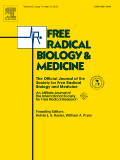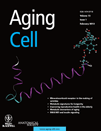
FREE RADICAL BIOLOGY AND MEDICINE
metrics 2024
Illuminating the Role of Free Radicals in Life Sciences
Introduction
FREE RADICAL BIOLOGY AND MEDICINE, published by Elsevier Science Inc, is a premier journal dedicated to the field of biochemistry and medical physiology. With an ISSN of 0891-5849 and an E-ISSN of 1873-4596, this journal stands out with its impressive ranking in the 2023 category quartiles: Q1 in Biochemistry and Q1 in Physiology (medical). Specifically, it has achieved a remarkable position of 29th out of 438 in Biochemistry and 8th out of 113 in Physiology, placing it firmly in the 93rd percentile of its field, as per Scopus rankings. Since its inception in 1987, the journal has focused on advancing the understanding of free radicals and their role in biological processes, encompassing a wide range of topics from oxidative stress to therapeutic applications. Although it does not currently offer open access, the journal's rigorous peer-review process and impactful research ensure that it remains a valuable resource for researchers and professionals seeking to explore the intricate relationships between free radicals and health. The journal's headquarters are located at STE 800, 230 Park Ave, New York, NY 10169, reflecting its esteemed place within the scientific community and commitment to high-quality research.
Metrics 2024
 1.75
1.75 7.10
7.10 7.90
7.90 303
303Metrics History
Rank 2024
Scopus
IF (Web Of Science)
JCI (Web Of Science)
Quartile History
Similar Journals

BIOCHIMICA ET BIOPHYSICA ACTA-BIOENERGETICS
Leading the Charge in Biochemical DiscoveriesBIOCHIMICA ET BIOPHYSICA ACTA-BIOENERGETICS is a prestigious journal published by Elsevier, dedicated to advancing the fields of biochemistry, biophysics, and cell biology. Established in 1967, this journal is committed to disseminating high-quality research that unveils the molecular mechanisms of bioenergetics, encompassing a wide range of topics from mitochondrial function to energy metabolism. With an exceptional impact factor and a current ranking in the Q1 quartile across multiple categories—specifically ranked #13 in Biophysics and featuring strong positions in Biochemistry and Cell Biology—this journal is recognized for its influential contributions to the scientific community. Scholars, researchers, and students globally benefit from its rigorous peer-review process and access options, although it is not currently open access. By providing a platform for innovative research, BIOCHIMICA ET BIOPHYSICA ACTA-BIOENERGETICS plays a critical role in fostering scientific advancement and collaboration among professionals in the field.

GeroScience
Catalyzing Collaboration in Aging StudiesGeroScience, published by Springer, is an esteemed open-access journal that focuses on the multidisciplinary field of aging research. Since its inception in 2017, the journal has quickly established itself as a leader in its field, achieving impressive Q1 quartile rankings across various categories, including Aging, Cardiology and Cardiovascular Medicine, Geriatrics and Gerontology, and Complementary and Alternative Medicine, as per 2023 evaluations. With a significant impact factor that underscores its influence and reach in academia, GeroScience aims to disseminate high-quality research that addresses the complex challenges and advancements related to aging. Its accessible publication format fosters greater dissemination of knowledge and encourages collaboration among researchers, practitioners, and students eager to contribute to the growing body of work on age-related health issues. As it continues to thrive, GeroScience remains a pivotal resource for anyone looking to stay at the forefront of aging research.

AGING CELL
Exploring the Frontiers of Aging ResearchAGING CELL is a premier peer-reviewed journal published by Wiley, specializing in the rapidly evolving field of aging research and cell biology. Established in 2002 and enjoying an impressive track record as evidenced by its Q1 ranking in both Aging and Cell Biology categories for 2023, the journal has become a vital resource for researchers and professionals alike. With a significant impact factor highlighting its scholarly influence, AGING CELL offers an open access model since 2014, ensuring that groundbreaking research is accessible to the global community. The journal covers a wide array of topics related to the mechanisms of aging at the cellular and molecular levels, making it essential reading for anyone invested in understanding the complexities of aging processes and their implications for health and disease. With a broad international readership based in the United Kingdom and beyond, AGING CELL is dedicated to disseminating high-quality research that impacts scientific understanding and fosters advances in the field.

CELL
Leading the charge in innovative biochemistry research.CELL is a premier academic journal in the field of Biochemistry, Genetics, and Molecular Biology, published by CELL PRESS. Founded in 1974, this esteemed journal has steadfastly contributed to advancing our understanding of cellular processes and organisms, making it integral for researchers and practitioners alike. With an impressive impact factor that places it in the Q1 category of its field, CELL ranks #1 out of 221 in general biochemistry and genetics, achieving a remarkable 99th percentile in Scopus rankings. Though it is not currently an open-access publication, the journal regularly disseminates high-quality research that impacts the scientific community significantly. Researchers, students, and professionals seeking to stay at the forefront of innovative discoveries and methodologies in molecular biology will find CELL an invaluable resource through its comprehensive articles and reviews.

Aging-US
Exploring the Frontiers of Aging and Cell BiologyAging-US is a premier peer-reviewed journal dedicated to advancing the field of aging research and cell biology. Published by IMPACT JOURNALS LLC, this journal serves as a vital resource for researchers and professionals exploring the biological mechanisms of aging and their implications for health and disease. With a commendable impact factor reflected in its 2023 Scopus rankings, where it stands at Rank #10/38 in the category of Aging and Rank #63/285 in Cell Biology, Aging-US exemplifies rigorous scientific excellence. Its open access policy enhances accessibility, fostering a wider dissemination of knowledge in both academic and clinical settings. Spanning from 2009 to 2024, the journal provides a platform for groundbreaking studies and innovative methodologies, ensuring that it remains at the forefront of the dynamic conversations surrounding aging and cellular biology. Engage with Aging-US to contribute to the evolving narratives of longevity and cellular health.

ANTIOXIDANTS & REDOX SIGNALING
Unraveling the Complexities of Redox SignalingANTIOXIDANTS & REDOX SIGNALING, published by MARY ANN LIEBERT, INC, is a premier journal dedicated to advancing the understanding of oxidative stress, antioxidants, and redox biology in various health contexts. With an impressive track record since its inception in 1999, this journal has continually evolved, currently converging towards 2024 as a core resource for researchers in biochemistry, cell biology, and molecular medicine. It holds a distinguished position in Q1 across several categories, including Biochemistry, Cell Biology, and Clinical Biochemistry, reflecting its critical role in disseminating high-quality research that impacts the fields of physiology and medicine. Despite not being an open-access journal, ANTIOXIDANTS & REDOX SIGNALING is renowned for its rigorous peer-review process and wide reach, ensuring that published articles are both influential and accessible to professionals, academia, and students alike. Researchers can benefit from its comprehensive articles that delve into cutting-edge discoveries and emerging therapies related to oxidative stress and its biological implications.

INTERNATIONAL JOURNAL OF BIOCHEMISTRY & CELL BIOLOGY
Pioneering Research in Biochemistry and Cell DynamicsThe International Journal of Biochemistry & Cell Biology, published by Pergamon-Elsevier Science Ltd, stands as a pivotal resource in the fields of biochemistry and cell biology. With an ISSN of 1357-2725 and an E-ISSN of 1878-5875, this prestigious journal has been a key platform for disseminating cutting-edge research since its inception in 1995. The journal currently holds an impressive Q1 ranking in Biochemistry and a Q2 ranking in Cell Biology for the year 2023, reflecting its commitment to high-quality research and its influence within the scientific community. With a significant Scopus ranking of 94/438 in Biochemistry and 96/285 in Cell Biology, the journal plays a crucial role in advancing knowledge and fostering innovative approaches in these dynamic fields. Though it is not an open-access journal, the International Journal of Biochemistry & Cell Biology remains accessible to a wide audience, making it a vital resource for researchers, professionals, and students alike, who are eager to explore and contribute to the ongoing advancements in biochemistry and cell biology.

Antioxidants
Unlocking the secrets of oxidative stress mitigation.Antioxidants is a premier open-access journal published by MDPI that has been actively contributing to the field of antioxidant research since its inception in 2012. Based in Switzerland, the journal holds a noteworthy impact factor indicative of its scholarly influence, particularly given its high rankings in various categories. As of 2023, it proudly sits in the Q1 quartile in Biochemistry, Clinical Biochemistry, Food Science, and Physiology, solidifying its status as a critical resource for innovative studies. With a strong focus on the roles of antioxidants across multiple disciplines—ranging from molecular biology to food science—this journal serves as a vital platform for researchers, professionals, and students aiming to advance knowledge in mitigating oxidative stress and enhancing health through dietary and therapeutic approaches. The open-access model guarantees wide accessibility, allowing for the dissemination of significant research findings globally, making it indispensable for anyone engaged in modern biochemical and physiological studies.

JOURNAL OF PHYSIOLOGY AND BIOCHEMISTRY
Pioneering Research in Physiology and BiochemistryJOURNAL OF PHYSIOLOGY AND BIOCHEMISTRY, published by Springer in the Netherlands, serves as a pivotal platform for disseminating high-quality research within the fields of physiology, biochemistry, and related biomedical sciences. With an impressive impact factor reflected in its categorization as Q2 in Biochemistry and Q1 in Medicine (miscellaneous), this journal fosters a vibrant community of scholars dedicated to advancing knowledge and innovation. The journal’s broad scope encompasses a wide range of topics from cellular mechanisms to systemic physiology, making it relevant for both theoretical and applied sciences. Researchers and practitioners are encouraged to utilize the available Open Access options to reach a wider audience. The journal’s continuous contribution to the scientific dialogue since its inception in 1996 positions it as a key resource for professionals and students alike, facilitating the exploration of cutting-edge topics and collaborative research opportunities.

BIOFACTORS
Innovating Insights into Biological Factors and Clinical ApplicationsBIOFACTORS, an esteemed journal published by Wiley, serves as a pivotal resource in the fields of Biochemistry, Clinical Biochemistry, and Molecular Medicine. With ISSN 0951-6433 and E-ISSN 1872-8081, the journal has established its reputation since its inception in 1988, showcasing a rich history of scientific inquiry and innovation. Recognized for its high academic standards, it currently holds a Q1 ranking in key categories, including Biochemistry and Medicine (miscellaneous), and ranks in the top 10% for Clinical Biochemistry according to Scopus metrics, reflecting its impact and influence in the scientific community. Although it does not offer Open Access, BIOFACTORS provides researchers the opportunity to publish and disseminate high-quality studies that advance our understanding of biological factors and their clinical implications. The journal actively encourages contributions that bridge the gap between laboratory findings and clinical applications, making it a vital platform for both seasoned researchers and emerging scholars in the life sciences.